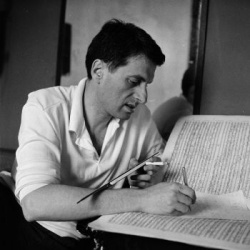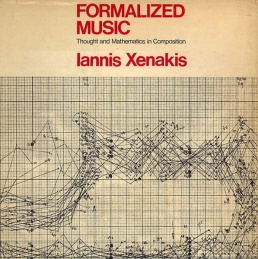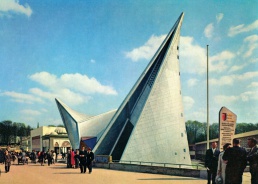Difference between revisions of "Iannis Xenakis"
| Line 25: | Line 25: | ||
* ''[http://monoskop.org/log/?p=11978 Music and Architecture: Architectural Projects, Texts, and Realizations]'', ed. & trans. Sharon Kanach, Hillsdale/NY: Pendragon Press, 2008, 337 pp. | * ''[http://monoskop.org/log/?p=11978 Music and Architecture: Architectural Projects, Texts, and Realizations]'', ed. & trans. Sharon Kanach, Hillsdale/NY: Pendragon Press, 2008, 337 pp. | ||
* ''[http://issuu.com/drawingcenter/docs/drawingpapers88_xenakis Iannis Xenakis: Architect, Composer, Visionary]'', The Drawing Center, 2010. Catalogue of his drawings. With essays by Ivan Hewett, Carey Lovelace, Sharon Kanach, and Mâkhi Xenakis. | * ''[http://issuu.com/drawingcenter/docs/drawingpapers88_xenakis Iannis Xenakis: Architect, Composer, Visionary]'', The Drawing Center, 2010. Catalogue of his drawings. With essays by Ivan Hewett, Carey Lovelace, Sharon Kanach, and Mâkhi Xenakis. | ||
| + | * [http://www.iannis-xenakis.org/xen/write/_books.html More] | ||
; Bibliography | ; Bibliography | ||
| Line 32: | Line 33: | ||
* [[Media:L_Arc_51_Xenakis_1972.pdf|''L'Arc'', 51: Special Issue on Xenakis]], Aix-en-Provence, 1972, 88 pp. (in French) | * [[Media:L_Arc_51_Xenakis_1972.pdf|''L'Arc'', 51: Special Issue on Xenakis]], Aix-en-Provence, 1972, 88 pp. (in French) | ||
* James Harley, ''Xenakis: His Life in Music'', 2004. | * James Harley, ''Xenakis: His Life in Music'', 2004. | ||
| + | * Dimitris Exarchos, ''[[Media:Exarchos_Dimitrios_2007_Iannis_Xenakis_and_Sieve_Theory_Vol_1_Text.pdf|Iannis Xenakis and Sieve Theory: An Analysis of the Late Music (1984-1993)]]'', London: Goldsmiths, 2007. [[Exarchos_Dimitrios_2007_Iannis_Xenakis_and_Sieve_Theory_Vol_2_Figures_and_Appendices.pdf|Figures and Appendices]]. Dissertation. [http://ethos.bl.uk/OrderDetails.do?uin=uk.bl.ethos.487206] | ||
* Fritz van der Waa, [http://www.careylovelace.com/docs/XenakisCalculatedSoundChaosVPROGids_5272011.pdf "Xenakis' Calculated Sound Chaos"], 2011. | * Fritz van der Waa, [http://www.careylovelace.com/docs/XenakisCalculatedSoundChaosVPROGids_5272011.pdf "Xenakis' Calculated Sound Chaos"], 2011. | ||
* [http://www.baunetz.de/dl/1228251/baunetzwoche_237_2011.pdf "Xenakis: Architektur+Musik"], ''BaunetzWoche'' 237 (2011), pp 4-20. (in German) | * [http://www.baunetz.de/dl/1228251/baunetzwoche_237_2011.pdf "Xenakis: Architektur+Musik"], ''BaunetzWoche'' 237 (2011), pp 4-20. (in German) | ||
* Charles Turner, ''[http://monoskop.org/log/?p=12791 Xenakis in America]'', Tappan/NY: One Block Avenue, 2014, 146 pp. | * Charles Turner, ''[http://monoskop.org/log/?p=12791 Xenakis in America]'', Tappan/NY: One Block Avenue, 2014, 146 pp. | ||
| + | |||
| + | ; Bibliography | ||
| + | * [http://www.iannis-xenakis.org/xen/read/biblio.html Annotated bibliography], produced by Makis Solomos. | ||
==Links== | ==Links== | ||
Revision as of 19:58, 11 November 2014
 | |
| Born |
May 29, 1922 Brăila, Romania |
|---|---|
| Died |
February 4, 2001 (aged 78) Paris, France |
Iannis Xenakis (Ιάννης Ξενάκης, 1922–2001) was a Greek-French composer, music theorist, and architect-engineer.
Studied engineering in Athens; upon graduation, he joined the studio of Le Corbusier in Paris, and worked with him on architectural projects for 12 years, most importantly the Sainte Marie de La Tourette, on which the two architects collaborated, and the Philips Pavilion at Expo 58, which Xenakis designed alone. It was not until he was nearly 30 that he undertook serious musical studies; enrolled in the class of Messiaen, and also took lessons with Honegger and Milhaud. Bypassing Schoenbergian dodecaphony and Webernian serialism, he began writing music according to the mathematical theories of sets and calculus of probability. In 1962 Xenakis wrote two pieces for the IBM 7090 computer, Morsima-Amorsima (ST/4–2, 030762) [Stochastic Music for 4 Performers, No. 1] and ST/10–1, 080262 (FLAC, analysis); programmed the music specifying duration and density of "sound events", leaving the parameters of pitch, velocity, and dynamics to the computer; both pieces were performed at the Technological Institute of Athens on 16 December 1962, sponsored by Hatzidakis (see below) and conducted by Lukas Foss. Among his important works are Metastaseis (1953-54, score) for orchestra, which introduced independent parts for every musician of the orchestra; percussion works such as Psappha (1975) and Pléïades (1979); and compositions that introduced spatialization by dispersing musicians among the audience, such as Terretektorh (1966). In 1979, he perfected the Polyagogic Method (UPIC), through which computer graphic images converted into musical structures. In Polytopes, a work whose title refers to Euclidean geometry, music is combined with visual stimuli in space (video).
Recordings
- Sound works on UbuWeb
- 6 electronic music pieces (FLAC, torrent)
Writings, books and catalogues

- Musiques formelles. Noveaux principes formels de composition musicale, Paris: Richard Masse, 1963, 232 pp. (in French)
- Formalized Music: Thought and Mathematics in Composition, Indiana University Press, 1971; new ed., exp., Hillsdale, NY: Pendragon Press, 1992, 387 pp.
- Kéleütha: écrits, intro. & notes Benoit Gibson, Paris: L'Arche, 1994, 143 pp. Collected writings. (in French)
- Music and Architecture: Architectural Projects, Texts, and Realizations, ed. & trans. Sharon Kanach, Hillsdale/NY: Pendragon Press, 2008, 337 pp.
- Iannis Xenakis: Architect, Composer, Visionary, The Drawing Center, 2010. Catalogue of his drawings. With essays by Ivan Hewett, Carey Lovelace, Sharon Kanach, and Mâkhi Xenakis.
- More
- Bibliography
- Iannis Xenakis Bibliography and Discography, compiled by James Harley.
Literature
- L'Arc, 51: Special Issue on Xenakis, Aix-en-Provence, 1972, 88 pp. (in French)
- James Harley, Xenakis: His Life in Music, 2004.
- Dimitris Exarchos, Iannis Xenakis and Sieve Theory: An Analysis of the Late Music (1984-1993), London: Goldsmiths, 2007. Figures and Appendices. Dissertation. [1]
- Fritz van der Waa, "Xenakis' Calculated Sound Chaos", 2011.
- "Xenakis: Architektur+Musik", BaunetzWoche 237 (2011), pp 4-20. (in German)
- Charles Turner, Xenakis in America, Tappan/NY: One Block Avenue, 2014, 146 pp.
- Bibliography
- Annotated bibliography, produced by Makis Solomos.
